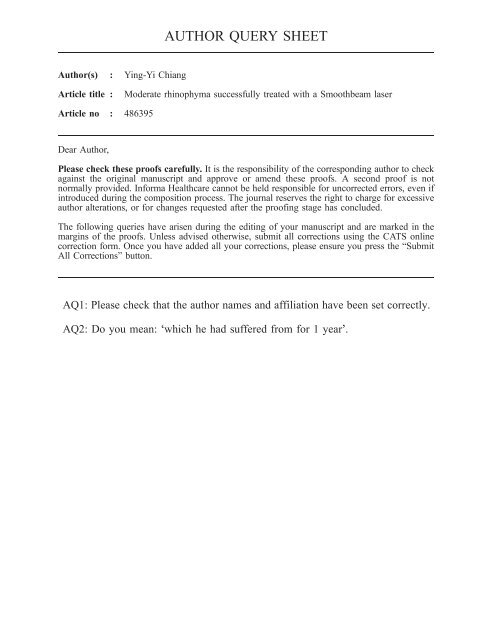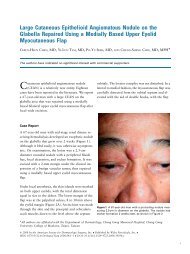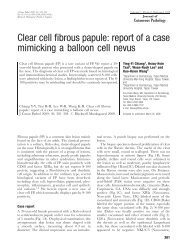AUTHOR QUERY SHEET
AUTHOR QUERY SHEET
AUTHOR QUERY SHEET
Create successful ePaper yourself
Turn your PDF publications into a flip-book with our unique Google optimized e-Paper software.
<strong>AUTHOR</strong> <strong>QUERY</strong> <strong>SHEET</strong><br />
Author(s) : Ying-Yi Chiang<br />
Article title :<br />
Moderate rhinophyma successfully treated with a Smoothbeam laser<br />
Article no : 486395<br />
Dear Author,<br />
Please check these proofs carefully. It is the responsibility of the corresponding author to check<br />
against the original manuscript and approve or amend these proofs. A second proof is not<br />
normally provided. Informa Healthcare cannot be held responsible for uncorrected errors, even if<br />
introduced during the composition process. The journal reserves the right to charge for excessive<br />
author alterations, or for changes requested after the proofing stage has concluded.<br />
The following queries have arisen during the editing of your manuscript and are marked in the<br />
margins of the proofs. Unless advised otherwise, submit all corrections using the CATS online<br />
correction form. Once you have added all your corrections, please ensure you press the “Submit<br />
All Corrections” button.<br />
AQ1: Please check that the author names and affiliation have been set correctly.<br />
AQ2: Do you mean: ‘which he had suffered from for 1 year’.
MJDT_A_486395.3d Wednesday, 9th June 2010 09:54:55<br />
Journal of Dermatological Treatment. 2010; 00:000–000<br />
1 LETTER<br />
2 Moderate rhinophyma successfully treated with a Smoothbeam laser<br />
3 CHIA-LUN CHOU & YING-YI CHIANG *<br />
4 Department of Dermatology, Taipei Medical University-Wan Fang Hospital, 111 Hsing-Long Road, Section 3,<br />
5 AQ1 Taipei 116, Taiwan<br />
6 Sirs,<br />
7 Rhinophyma, the end stage of evolving rosacea, is a<br />
8 disfiguring disorder of the nose characterized by an<br />
9 erythematous swollen nose with prominent pilosebac-<br />
10 eous dilated pores and telangiectasia. Rhinophyma<br />
11 occurs much more often in men than in women (with<br />
12 an approximate ratio of 20:1), although rosacea is<br />
13 more common in females (1). Histopathologically,<br />
14 rhinophyma shows prominent sebaceous hyperplasia,<br />
15 dilated infundibula, telangiectasia in the superficial<br />
16 dermis, and perifollicular inflammatory cell infiltra-<br />
17 tion (2). Clinically, marked skin thickening and irreg-<br />
18 ular surface nodularities of the nose cause cosmetic<br />
19 embarrassment and distress for patients. Herein, we<br />
20 describe the successful treatment of moderate rhino-<br />
21 phyma with a 1450-nm diode laser as an effective and<br />
22 safe alternative.<br />
23 An 80-year-old man was diagnosed with phymatous<br />
24 AQ2 rosacea for 1 year. He suffered from several painful<br />
25 erythematous papules and pustules over the glabella,<br />
26 bilateral cheeks, and nose. The patient’s nose showed<br />
27 features of rhinophyma, including persistent ery-<br />
28 thema, telangiectasia, thickening, and irregular<br />
29 surface contours (Figure 1). He had received medical<br />
30 treatment including topical metronidazole and oral<br />
31 doxycycline 100 mg bid for 8 weeks continuously.<br />
32 However, the clinical response was limited. There-<br />
33 fore, we used a 1450-nm diode laser with a cryogen<br />
34 cooling spray (SmoothbeamÔ; Candela Corp.,<br />
35 Wayland, MA, USA) as an alternative treatment.<br />
36 Pretreatment anesthetic cream (5% EMLA) was<br />
37 applied 1 hour before the laser to reduce the patient’s<br />
38 discomfort. The following treatment variables were<br />
used: a spot size of 4 mm, a fluence of 17 J/cm 2 ,a<br />
pulse duration of 210 ms, and a dynamic cooling<br />
device (DCD) spray duration of 28 ms. His nose<br />
was treated with a single non-overlapping pass. Three<br />
treatment sessions spaced 4 weeks apart were given.<br />
We chose the same treatment fluence as a previous<br />
study for treating sebaceous hyperplasia (3). Moreover,<br />
the use of a single non-overlapping pass, a<br />
shorter duration of DCD spray, and delivery of treatments<br />
at 4-week intervals were thought to reduce the<br />
occurrence of post-inflammatory hyperpigmentation,<br />
especially in this Fitzpatrick skin type IV patient (4),<br />
since the duration of the cryogen spray and the length<br />
of the treatment intervals play important roles in<br />
causing hyperpigmentation (5). During the treatment,<br />
he only applied topical metronidazole, and<br />
his condition improved greatly. Only mild telangiectasia<br />
remained (Figure 2). Subjective satisfaction of<br />
both the patient and physician were assessed to exceed<br />
90% improvement, except there was transient pain<br />
during the procedure. No complications such as<br />
hyperpigmentation, blisters, or scarring were noted.<br />
The response of the Smoothbeam laser was maintained<br />
for more than 6 months, even without oral<br />
antibiotics (Figure 3).<br />
For early-stage rhinophyma, oral and topical antibiotics<br />
may reduce the inflammation, while oral<br />
and topical retinoids are beneficial in decreasing the<br />
sebaceous gland size and suppressing sebum secretions<br />
(6). For advanced rhinophyma, a wide range of<br />
effective surgical approaches including cryosurgery,<br />
electrosurgery/electrocautery, dermabrasion, and<br />
scalpel or razor blade excision were advocated.<br />
UNCORRECTED PROOF<br />
39<br />
40<br />
41<br />
42<br />
43<br />
44<br />
45<br />
46<br />
47<br />
48<br />
49<br />
50<br />
51<br />
52<br />
53<br />
54<br />
55<br />
56<br />
57<br />
58<br />
59<br />
60<br />
61<br />
62<br />
63<br />
64<br />
65<br />
66<br />
67<br />
68<br />
69<br />
70<br />
71<br />
*Correspondence: Fax: 886 2 8862 1197. E-mail: ellychiang@hotmail.com<br />
(Received 16 December 2009; accepted 14 March 2010)<br />
ISSN 0954-6634 print/ISSN 1471-1753 online Ó 2010 Informa UK Ltd.<br />
DOI: 10.3109/09546634.2010.486395
MJDT_A_486395.3d Wednesday, 9th June 2010 09:54:56<br />
2 C. Chou & Y. Chiang<br />
Figure 1. Rhinophyma before laser treatment. Multiple painful erythematous papulopustules over the nose and nasolabial folds are evident.<br />
Figure 2. After three treatment sessions. The severe erythema with nodularities were greatly improved.<br />
72 Nevertheless, surgical therapies have longer recovery<br />
73 times, and the possible complications may include<br />
74 poor hemostasis, uncontrolled depth of tissue destruc-<br />
75 tion, and cartilaginous necrosis (7). Ablative lasers<br />
76 (carbon dioxide and erbium:yttrium-aluminum-garnet<br />
77 lasers) have been reported to achieve remarkable<br />
hemostasis and cosmesis. However, post-treatment<br />
hypopigmentation and hyperpigmentation are common<br />
in patients with darker skin types (8). Furthermore,<br />
those treatments only improve the appearance<br />
of the rhinophyma rather than reduce the formation<br />
of papulopustules.<br />
The Smoothbeam laser, a 1450-nm diode laser, is<br />
used for treating active acne (4,9), atrophic acne<br />
scarring, sebaceous hyperplasia (3), and periorbital<br />
rhytides (5). This laser emits a wavelength of<br />
1450 nm, which is absorbed by water within the<br />
dermis at 100–600 mm deep, leading to the selective<br />
photothermal destruction of sebaceous glands,<br />
thereby reducing sebum production (9). It improves<br />
the nasal contour resulting from sebaceous hyperplasia,<br />
and also concurrently decreases painful inflammatory<br />
papulopustular eruptions. Compared with<br />
other therapies, there is less pain, no bleeding, and<br />
no downtime.<br />
In summary, we successfully treated rhinophyma<br />
with good cosmesis and no complications in an outpatient<br />
setting. For patients with moderate rhinophyma<br />
presenting with painful papulopustules and<br />
nodularities of the nose, which are refractory to oral<br />
UNCORRECTED PROOF<br />
Figure 3. Six months after three Smoothbeam laser treatments.<br />
78<br />
79<br />
80<br />
81<br />
82<br />
83<br />
84<br />
85<br />
86<br />
87<br />
88<br />
89<br />
90<br />
91<br />
92<br />
93<br />
94<br />
95<br />
96<br />
97<br />
98<br />
99<br />
100<br />
101
MJDT_A_486395.3d Wednesday, 9th June 2010 09:55:26<br />
Letter 3<br />
102 and topical medications, the Smoothbeam laser is a<br />
103 safe, easy-to-handle, and effective treatment option.<br />
104 Acknowledgement<br />
105 The authors report no funding sources and no<br />
106 conflicts of interest.<br />
107 References<br />
108 1. Roberts JO, Ward CM. Rhinophyma. J R Soc Med. 1985;78:<br />
109 678–681.<br />
110 2. Aloi F, Tomasini C, Soro E, Pippione M. The clinicopathologic<br />
111 spectrumofrhinophyma.JAmAcadDermatol.2000;42:468–472.<br />
112 3. No D, McClaren M, Chotzen V, Kilmer SL. Sebaceous hyper-<br />
113 plasia treated with a 1450-nm diode laser. Dermatol Surg.<br />
114 2004;30:382–384.<br />
4. Noborio R, Nishida E, Morita A. Clinical effect of low-energy<br />
double-pass 1450 nm laser treatment for acne in Asians. Photodermatol<br />
Photoimmunol Photomed. 2009;25:3–7.<br />
5. Tanzi EL, Williams CM, Alster TS. Treatment of facial rhytides<br />
with a nonablative 1,450 nm diode laser: A controlled<br />
clinical and histologic study. Dermatol Surg. 2003;29:<br />
124–128.<br />
6. Gupta AK, Chaudhry MM. Rosacea and its management:<br />
An overview. J Eur Acad Dermatol Venereol. 2005;19:<br />
273–285.<br />
7. Sadick H, Goepel B, Bersch C, Goessler U, Hoermann K,<br />
Riedel F. Rhinophyma: Diagnosis and treatment options for<br />
a disfiguring tumor of the nose. Ann Plast Surg. 2008;61:<br />
114–120.<br />
8. Madan V, Ferguson JE, August PJ. Carbon dioxide laser<br />
treatment of rhinophyma: A review of 124 patients. Br J<br />
Dermatol. 2009;161:814–818.<br />
9. Paithankar DY, Ross EV, Saleh BA, Blair MA,<br />
Graham BS. Acne treatment with a 1,450 nm wavelength laser<br />
and cryogen spray cooling. Lasers Surg Med. 2002;31:<br />
106–114.<br />
UNCORRECTED PROOF<br />
115<br />
116<br />
117<br />
118<br />
119<br />
120<br />
121<br />
122<br />
123<br />
124<br />
125<br />
126<br />
127<br />
128<br />
129<br />
130<br />
131<br />
132<br />
133<br />
134<br />
135





